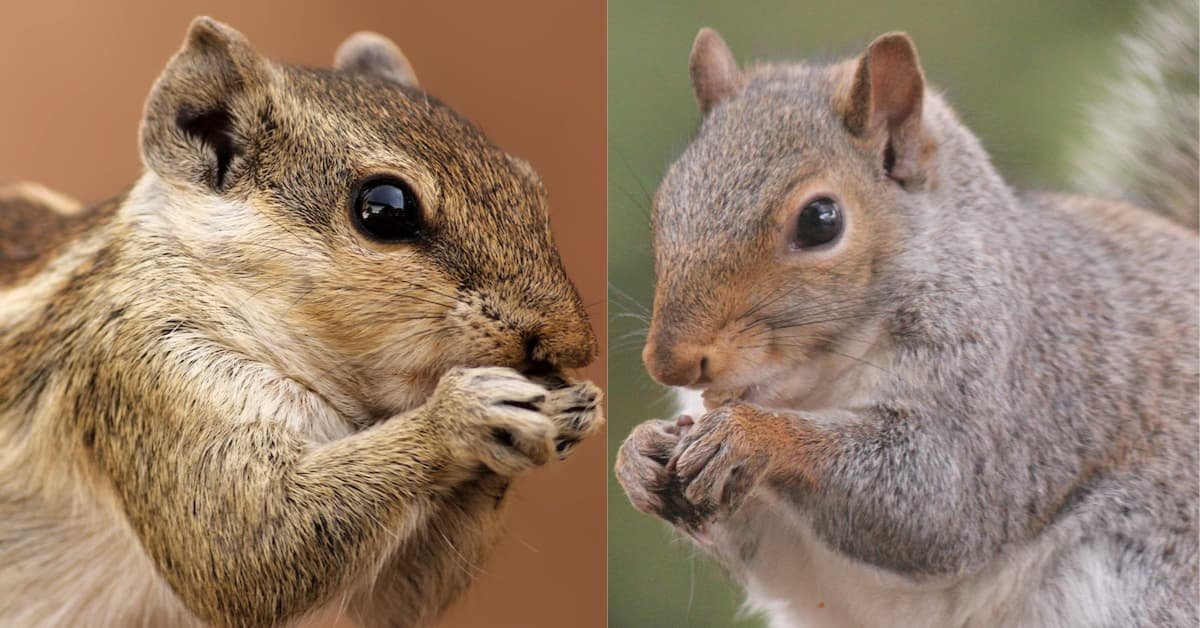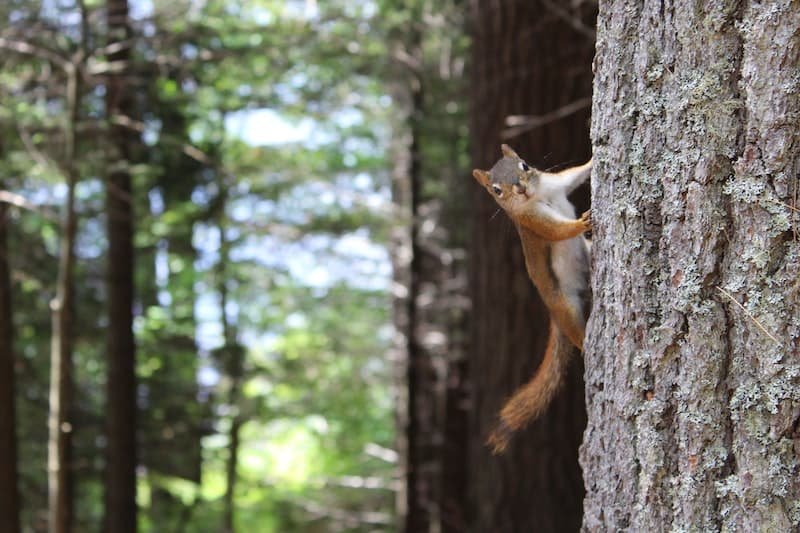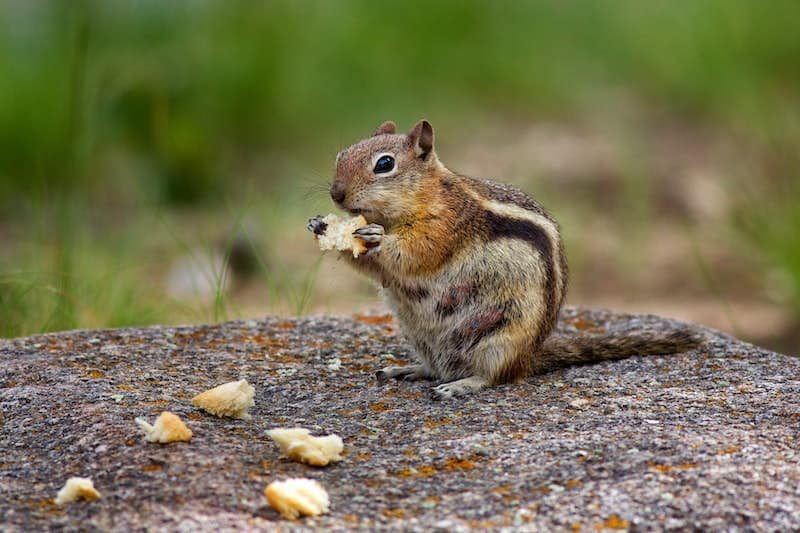
Chipmunks and squirrels are two of the most spotted animals in North America.
While they may share some similarities, such as their love for nuts and seeds, these creatures have distinct physical and behavioral traits that set them apart from each other.
In this article, we will dive into the differences between chipmunks and squirrels. We will explore their unique characteristics and habitats.
So, let’s dive in and explore the world of chipmunks Vs squirrels.
Short Summary
- Chipmunks are smaller in size and weight compared to squirrels. They have round bodies and short tails, while squirrels have longer, lankier bodies with bushy tails.
- Chipmunks primarily live in forests and bushy lands, while squirrels prefer living in trees and thrive in mature forests.
- Both have a similar diet, with chipmunks being omnivores and squirrels mainly herbivores.
- Chipmunks and squirrels differ in behavior, diet, habitat, and vocalization. They cannot be kept together in the same cage.
Physical Characteristics: Chipmunks Vs Squirrels
Chipmunks are smaller and have round bodies with short tails. Squirrels are larger and have lankier bodies with bushy tails.
Chipmunks have a compact body shape. This allows them to move swiftly on the ground and fit in small spaces.
Squirrels have a more elongated body shape that helps them climb trees and jump from branch to branch.
The fur color of both animals is also a distinguishing feature. Chipmunks have a reddish-brown fur color with white stripes on their face and body.
Squirrels have a range of colors from gray to brown with white bellies and darker stripes on their back.
These color patterns help them blend into their respective habitats, with chipmunks blending into the forest floor and squirrels blending into the tree bark.
The differences in body shape and fur color make it easy to tell the difference between the two animals.
Habitat and Lifestyle

The habitat and lifestyle of these two species differ significantly. Chipmunks primarily live in forests and bushy lands, while squirrels prefer living in trees and thrive in mature forests.
Chipmunks are ground creatures, while squirrels climb trees. Both animals are solitary and only socialize for mating. Yet, squirrels can group up during winter to share body temperatures and keep each other warm.
Adapting to winter is a crucial aspect of survival for both chipmunks and squirrels.
Chipmunks don’t hibernate during the entire winter and can search for food in the cold.
Squirrels add fat to their bodies and collect supplies to survive the cold season.
The impact of habitat loss on these animals is significant as they depend on specific environments to thrive.
As human development continues to encroach on natural habitats, chipmunks and squirrels are forced to adapt or die.
Understanding the differences between these two species can help preserve their unique habitats and the role they play in the ecosystem.
| Chipmunks | Squirrels |
|---|---|
| Round bodies and short tails | Longer, lankier bodies with bushy tails |
| Reddish-brown fur with long body stripes | Vary from gray to different brown shades with stripes only on their bodies |
| Prefer living in deciduous forests and bushy lands | Prefer living in trees and thrive in mature forests |
| Don’t hibernate during the entire winter and can search for food in the cold | Add fat to their bodies and collect supplies to survive the cold season |
Diet and Nutrition

Regarding diet and nutrition, it is interesting to note that squirrels can consume up to 1.5 pounds of food per week during the winter months.
This is to maintain their fat reserves and survive the cold season. Squirrels are mainly herbivores, but they do have omnivorous tendencies.
They consume a variety of nuts, seeds, fruits, and vegetables. In addition to these, they also eat insects, bird eggs, and small animals like baby birds and rodents.
Squirrels have a high nutritional need for carbohydrates and fats, which they get from nuts and seeds. They also need proteins for muscle maintenance, which they get from insects and small animals.
Here are 5 interesting facts about squirrel diet and nutrition:
- Squirrels have a unique way of processing nuts. They chew the nuts and then spit out the shell, which helps them to digest the nuts more easily.
- Squirrels have a special digestive system that allows them to extract more nutrients from their food than other animals with similar diets.
- Squirrels have a strong preference for certain types of nuts, such as acorns, hickory nuts, and walnuts. They will often store these nuts in large quantities for future use.
- Squirrels have a natural instinct to hoard food, which allows them to survive during periods of food scarcity. They will often bury nuts and other food items in the ground, and then dig them up when they need them.
- Squirrels have a keen sense of smell, which allows them to locate food that is hidden or buried underground. They can also detect the presence of predators using their sense of smell.
Interactions and Behavior
Interactions and behavior between chipmunks and squirrels can be influenced by various factors such as territoriality, mating, and food availability.
Chipmunks are generally territorial creatures and can become aggressive towards other chipmunks or squirrels that enter their territory.
They are known to chase away intruders and defend their burrows.
Squirrels tend to be less territorial and can often share their space with other squirrels.
In some cases, squirrels may even group together during winter to share body heat and keep each other warm.
Both chipmunks and squirrels are solitary creatures and only socialize for mating purposes.
Female chipmunks and squirrels can get along if raised together from a young age.
Pet chipmunks and squirrels cannot be kept in the same cage as chipmunks are territorial and aggressive.
Red squirrels, in particular, are highly aggressive and territorial and may even attack other animals including chipmunks.
Despite being part of the same family, Sciuridae, chipmunks, and squirrels generally do not interact or get along. They differ in behavior, diet, habitat, and vocalization.
Evolution and Classification
Evolutionary history and taxonomic relationships show intriguing insights into the paths taken by two closely related families of rodents, chipmunks, and squirrels.
These two families are part of the same family, Sciuridae, and have a common ancestor dating back around 20 million years ago.
Yet, the significant genetic resemblance is unlikely due to the different evolutionary paths taken by the two families.
Zoologists classify chipmunks and squirrels into two genera: Tamias for chipmunks and Sciurus for squirrels.
The table below summarizes the evolutionary and taxonomic relationships between the two families, highlighting their differences in physical characteristics, behavior, and habitat.
Despite their similarities, chipmunks and squirrels have distinct differences in their evolutionary history and classification.
| Evolutionary History | Taxonomic Relationships |
|---|---|
| Chipmunks and squirrels have a common ancestor dating back around 20 million years ago. | Zoologists classify chipmunks and squirrels into two genera: Tamias for chipmunks and Sciurus for squirrels. |
| Significant genetic resemblance is unlikely due to the different evolutionary paths taken by the two families. | Chipmunks and squirrels are part of the same family, Sciuridae. |
| Chipmunks and squirrels have distinct differences in their physical characteristics, behavior, and habitat. |
FAQs:
Can chipmunks and squirrels mate and produce offspring?
Chipmunks and squirrels cannot mate due to reproductive barriers and genetic incompatibility. Despite their shared family, Sciuridae, hybrid offspring are impossible due to different mating behaviors. Crossbreeding tendencies are absent.
How do chipmunks and squirrels communicate with each other?
Chipmunks and squirrels communicate with each other using scent marking and vocalization. Scent marking is important for marking territory. Vocalization is used for warning others of danger or to attract mates.
What are some common predators of chipmunks and squirrels?
Predators of chipmunks and squirrels include hawks, owls, foxes, snakes, and domestic cats. Understanding the ecological role of these animals is important for protecting them. Habitat preservation and controlling domestic cat populations are effective protection measures.
How do chipmunks and squirrels adapt to urban environments?
Chipmunks and squirrels have adapted to urban environments by using human-made structures as substitutes for natural habitats. They may nest in buildings, feed on human-provided resources, and even crossroads. But, habitat preferences still differ between the two species.
Are there any species of chipmunks or squirrels that are endangered?
According to the IUCN Red List, there are several species of chipmunks and squirrels that are endangered due to threats and habitat loss. Conservation efforts include breeding programs and population management to prevent further decline.



